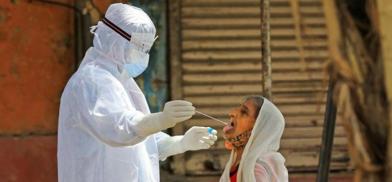Coronavirus: Total tally crosses 12,000 mark in India
With 941 new cases the total number of confirmed cases of novel coronavirus in India mounted to 12,380 stated the data published by the Ministry of Health and Family Welfare

New Delhi: With 941 new cases the total number of confirmed cases of novel coronavirus in India mounted to 12,380 stated the data published by the Ministry of Health and Family Welfare. Of these, 10,477 are active cases of COVID-19, 1,488 individuals have recovered and discharged from the hospital, one person migrated to another country and 414 people succumbed to the disease.
The total confirmed cases include 76 foreign nationals.
Maharashtra remained the worst-hit state with a total number of positive cases rising to 2,916, followed by New Delhi with 1,578 cases and Tamil Nadu, which has reported 1,242 cases and Rajasthan with 1,023 cases. according to the Health Ministry data.
India identifies its 'hotspots' and 'red zones'
New Delhi: After extending the nationwide lockdown, the Indian government has released a list of 170 hotspot districts, which includes all six metros and various other large cities. The list includes all nine districts of the national capital.
All the major metros including Delhi, Mumbai, Bengalauru, Chennai, Kolkata, and Hyderabad are part of the list of hotspots notified by the Health Ministry. Tamil Nadu tops the list with 22 districts in the hot spots while Rajasthan and Maharashtra are second on the list with 11 each.
Among the list of hotspot districts with large outbreaks are the nine districts of Delhi - South, South West, Shahdara, South East, West, North, Central, East and New Delhi.
Andhra Pradesh has 11 hot spots including Vishakhapatnam, Bihar has one hot spot in Siwan, entire Chandigarh is included, Chhatisgarh has Korba, Gujarat has five including Ahmedabad, Surat, Vadodara, and Rajkot, Haryana has four including Gurugram, Jammu and Kashmir has five including Srinagar, Jammu, and Baramulla, Karnataka has three including Bengaluru urban, Mysore, Belagavi, Kerala has six including Kasaragod and Kannur, Madhya Pradesh has five including Bhopal, Indore, and Ujjain, Maharashtra has 11 including Mumbai, Pune, Sangli, Nashik, Thane, Nagpur, Aurangabad, Odisha has only Khordha, Punjab has four including SAS Nagar, Jalandhar, and Pathankot, Rajasthan has 11 including Jaipur, Jodhpur, Tonk, Jaisalmer, Bhilwara, Bikaner, Bharatpur, and Kota, Tamil Nadu has 22 including Madurai, Tuticorin, Chennai, Salem, Cuddalore, Coimbatore, Erode, and Vellore, Telangana has eight including Hyderabad, Nizamabad, and Warangal, Uttar Pradesh has nine in Noida, Lucknow, Shamli, Firozabad, Moradabad, Saharanpur, Ghaziabad, Meerut, and Agra, Uttarakhand has Dehradun, West Bengal has four including Kolkata and Howrah.
According to the government a hotspot which will be called a red zone would be a district or city that contributes to more than 80 per cent of the cases in the country or the state. Apart from these places that show a high rate of infection, that is doubling rate less than 4 days - will also be in this category.
According to the list there are 207 other districts marked as potential hotspots and the government has now tasked the states to ensure containment of outbreak in these regions. The only way that a district or region can be brought out of the red zone is when there is no new case of Covid-19 for at least 28 continuous days, once this is achieved the district would be called green zone, that is Covid-19 free area.
Union Health Secretary Preeti Sudan also wrote to Chief Secretaries of states and Union Territories, asking them to divide their states and UTs into two sections -- hotspot and non-hotspot areas.
States also need to identify hotspots based on doubling rate of confirmed cases. The exercise of identification of hotspots, she says, has to be done on a weekly basis, every Monday. She has advised strict containment plans for such clusters.
Segregating areas into three zones, she said: "Containment operation would be deemed over when there is no case reported in 28 days from an area after the last case tests negative. Hotspots (designated red zones) will be assumed to be undertaking effective containment activities, if no case is reported in the next 14 days (designated orange zones) and will be deemed successful in containment, if no case is repofted for 28 days (designated green zones).









Post a Comment